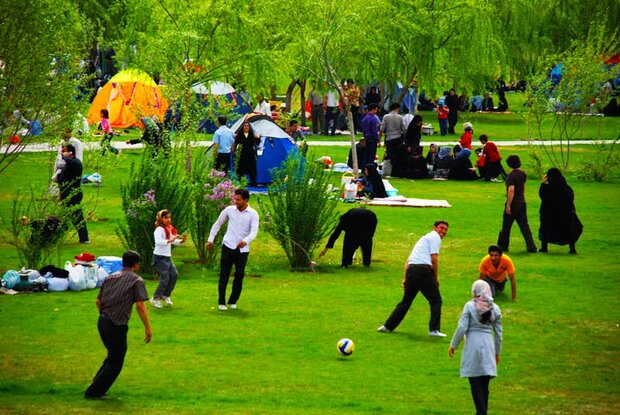Total: 0Toman
Iranian people embrace beauty of spring on Sizdah Bedar
On Nature's Day, locally known as Sizdah Bedar, Iranians relish the outdoors by visiting nearby parks, vibrant gardens, or scenic rural areas to commemorate this national holiday.

Sizdah Bedar, celebrated on the 13th day of Farvardin in the Iranian calendar, marks the end of Nowruz festivities with Iranians embracing nature to dispel bad luck associated with the number thirteen and welcome spring.
Sizdah Bedar serves as a joyful conclusion to Nowruz, with families gathering outdoors to ward off the perceived bad luck associated with the number thirteen by embracing spring.
The 13th day of Farvardin, the first month in the Iranian calendar, marks the celebration of an Iranian National Nature Day, referred to as ‘Sizdah Be-dar’, as a way to say goodbye to the Nowruz festivities.
A perfect Nowruz celebration requires a cheerful ending, so people head outdoors on the last day of the festivities to commemorate the conclusion of the Nowruz holidays.
On the 13th day of the Persian New Year, known as Nowruz, countless people will head outside to picnic in parks and the countryside around Iran. This event has significant historical ties to Iranian culture.
Sizdah Bedar serves as a joyful conclusion to Nowruz, with families gathering outdoors to ward off the perceived bad luck associated with the number thirteen by embracing spring.
Customs include dismantling the Sofreh-ye Haft Sin (the Nowruz centerpiece) and releasing the Sabzeh (sprouts) into flowing water, symbolizing the washing away of misfortune.
Unmarried women knot grass, hoping for good fortune in marriage. The day is filled with games, music, dancing, and feasting on traditional foods like ash-e reshteh (noodle soup), all intended to bring joy and dispel negative energies for the year ahead.
The collective cheer and merriment of Sizdah Bedar beautifully encapsulate the spirit of renewal that Nowruz embodies.
The celebration of Sizdah Bedar involves stepping outside into nature, a powerful symbol of releasing the past and welcoming fresh opportunities.
The act of discarding the Sabzeh is particularly poignant, representing a letting go of any stagnation or negativity that might have accumulated during the past year, allowing for fresh growth and prosperity in the coming one.
The laughter of children echoing through the parks, the aroma of grilled kebabs mingling with the scent of blooming flowers, and the vibrant colors of traditional attire all contribute to the festive ambiance.
Sizdah Bedar transcends a simple outdoor gathering; it embodies a cultural tradition that reflects a sincere wish for a year abundant in prosperity, wellness, and joy.
The celebration of Sizdah Bedar captures the spirit of resilience found in Iranian culture and highlights a significant relationship with the environment.
It is a testament to the enduring spirit of a people who find solace and renewal in the embrace of nature, celebrating life's simple joys and embracing the promise of a brighter future.
The day serves as a powerful reminder that even after periods of introspection and reflection, as experienced during the Nowruz celebrations, there comes a time to cast off the old and embrace the boundless possibilities that lie ahead.
The act of heading outdoors is not merely a recreational activity but a symbolic pilgrimage, a collective journey towards purification and rebirth.
It is a conscious decision to immerse oneself in the beauty and vitality of the natural world, allowing its restorative powers to wash away any lingering negativity and instill a sense of hope and optimism.
The traditions associated with Sizdah Bedar, from the dismantling of the Haft Sin to the tying of knots by unmarried women, are all deeply rooted in Iranian folklore and belief systems.
They represent a tangible connection to the past, a way of honoring ancestral customs and traditions while simultaneously embracing the present moment.
The sharing of food, particularly the savory ash-e reshteh, further strengthens the bonds of community and kinship, fostering a sense of togetherness and shared joy.
Laughter, music, and dance fill the air, creating an atmosphere of unbridled merriment and celebration.
As the sun begins to set on Sizdah Bedar, casting a golden glow over the landscape, there is a palpable sense of gratitude and contentment.
The day has served its purpose as a joyful conclusion to Nowruz and a reaffirmation of hope, resilience, and the enduring power of the human spirit.
As families return to their homes, they carry with them the blessings of nature, the warmth of shared experiences, and the unwavering belief that the year ahead will be filled with good fortune, health, and happiness.
As a result, Sizdah Bedar is not simply a date on the calendar; it is a treasured practice, a key element of Iranian culture that enhances the sense of identity and embodies the ageless spirit of Nowruz.





















.jpeg)




Write your comment.